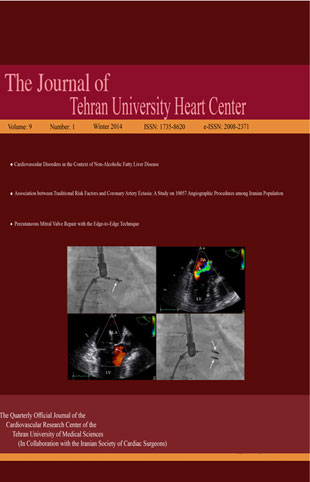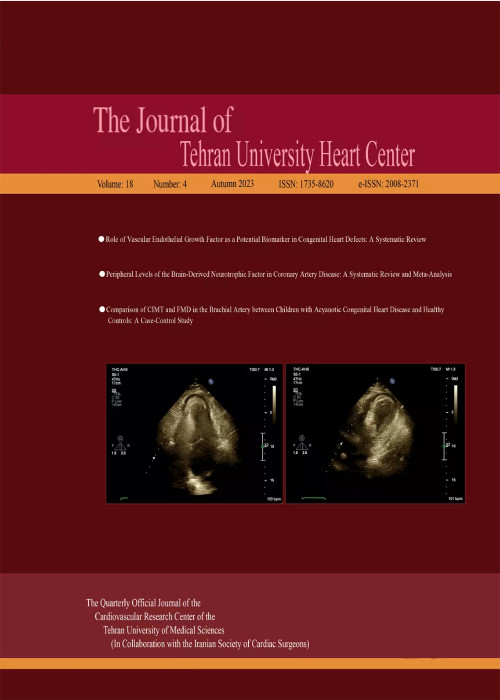فهرست مطالب

The Journal of Tehran University Heart Center
Volume:9 Issue: 1, Jan 2014
- تاریخ انتشار: 1393/01/16
- تعداد عناوین: 10
-
-
Pages 1-8Non-alcoholic fatty liver disease (NAFLD) is the leading cause of chronic liver disease in the United States and other industrialized countries, and the reported prevalence in the developing countries is also rather high. This disease is associated with a high rate of morbidity and mortality and damage to the other organs. The cardiovascular system is, perhaps, the most vulnerable organ to NAFLD adverse effects to the extent that most mortality associated with this disease is reportedly from the cardiovascular system rather than from the liver itself. In this article, we review the significant aspects of cardiovascular disorders associated with NAFLD, including the epidemiology of cardiovascular diseases in NAFLD patients, factors that interfere in this relationship like hypertension, severity of NAFLD, and age of the patients, and finally preventive strategies whose employment could significantly improve the outcome.
-
Pages 9-14BackgroundCongenital heart disease (CHD) is the most common congenital anomaly in newborns. This study was performed to determine the live birth incidence of CHD by ethnicity and sex in Gorgan, Northern Iran.MethodsIn this longitudinal, hospital-based study, 18162 live births in Dezyani Hospital in Gorgan, North of Iran, were screened for CHD, from 2007 through 2009. Clinical examination, echocardiography, color Doppler, and cardio catheterization were used as diagnostic tools. Sex, ethnicity, and type of CHD for each case were recorded in a pre-designed questionnaire.ResultsThe incidence rates of CHD in the native Fars, Sistani, and Turkmen subjects were 5.73 (95%CI: 4.53-7.15), 12.27 (95%CI: 8.74-16.73), and 15.93 (95%CI: 10.00-24.02) per 1000 live births, respectively. The Turkmen to native Fars and Sistani to native Fars relative risk for congenital CHD malformations was 2.77 (95%CI: 1.73-4.44; p value < 0.001) and 1.29 (95%CI: 0.77-2.18; p value < 0.323), respectively. While atrial septal defect was the most common lesion in the native Fars subjects (2.14 per 1000 [95%CI: 1.42-3.06]) and in the Sistani subjects (2.84 per 1000 [95%CI: 1.29-5.36]), in the Turkmen subjects, ventricular septal defect (4.36 per 1000 [95%CI: 1.59-9.43]), followed by atrial septal defect, was the most frequent lesion.ConclusionThis study showed that the incidence and pattern of CHD among live births in Gorgan, North of Iran, varied according to ethnicity. The risk of CHD was higher in the Turkmen and Sistani groups than in the Fars population.
-
Pages 15-19BackgroundEuroSCORE is a simple and rigorous risk stratification model and is, thus, commonly used in predicting the early and late outcomes of cardiac surgery across the world. We aimed to assess the discriminative power of the EuroSCORE model to predict postoperative morbidity and total prolonged length of stay in hospital (LOS) and Intensive Care Unit (ICU) stay in an Iranian group of cardiac surgical population.MethodsIn a prospective study, the additive EuroSCORE model was applied to 570 patients undergoing isolated coronary artery bypass grafting (CABG) at Tehran Heart Center. The discrimination power of the EuroSCORE model was tested by the area under the receiver operating characteristic (ROC) curve and the calibration by comparing the observed and predicted outcomes across the risk spectrum assessed using the Hosmer-Lemeshow goodness-of-fit test.ResultsMean age was 59.03±0.73 years and 429 out of 570 (75.3%) patients were men. The overall morbidity rate was 47.5%. The observed morbidity in the high-risk patients (EuroSCORE > 6) was significantly greater than that in the low-risk patients (EuroSCORE ≤ 6). Furthermore, 51.2% of the patients had LOS beyond 14 days. Both prolonged LOS (> 14 days) and prolonged ICU stay (> 72 hours) were more prevalent in the high-risk group than in the low-risk group. The discriminative power of EuroSCORE in predicting morbidity, prolonged LOS, and ICU stay was poor with an area under the ROC curve of 0.617, 0.598, and 0.581, respectively. However, this risk score showed good calibrations for morbidity (p value = 0.119), prolonged LOS (p value = 0.958), and prolonged ICU stay (p value = 0.620).ConclusionEuroSCORE provided inappropriate discrimination in predicting early morbidity and prolonged LOS and ICU stay in our study population. Creating a revised model may enable us to accurately predict outcomes in Iranian CABG patients.
-
Pages 20-26IntroductionCoronary artery disease is one of the most common causes of morbidity and mortality in developed countries. Atherosclerosis begins in early childhood and progresses through life. With advances in pediatric cardiology, the prevalence of congenital heart disease in adults has increased in relation to children. A great deal of research has been conducted on serum glucose and lipid concentrations in patients with congenital heart disease, but comparison has yet to be made between congenital patients and the general population, especially in pediatric groups. The aim of this study was to compare the serum concentrations of glucose and lipids between pediatric congenital heart disease patients and a healthy age and sex-matched control group.MethodsWe measured and compared the total cholesterol, low-density lipoprotein (LDL) cholesterol, high-density lipoprotein (HDL) cholesterol, triglyceride (TG), and plasma glucose concentrations of 100 pediatric congenital heart disease patients (cases) and 100 individuals matched for age and sex (controls) during a period of 7 months between November 2011 and June 2012.ResultsTotal cholesterol, triglyceride, HDL cholesterol, and LDL cholesterol concentrations were significantly higher in the patients than in the control group (p value < 0.05). Blood sugar levels in both groups had no significant difference (p value = 0.25). In the case group, the cholesterol level was higher in the males than in the females (p value = 0.30); moreover, the TG and HDL cholesterol levels were lower in the males than in the females and the LDL cholesterol and blood sugar levels had no statistically significant difference. In the control group, there was no difference between the males and females in terms of the cholesterol, HDL cholesterol, LDL cholesterol, TG, and blood sugar levels.ConclusionThe results of this study showed that our pediatric congenital heart disease patients had significantly higher levels of serum lipids than did their age and sex-matched controls. In light of these results, we recommend that the lipid profile be screened in children with congenital heart disease so as to reduce the risk of atherosclerosis.
-
Pages 27-32BackgroundWhether coronary artery ectasia (CAE) is a unique clinical finding or results from other clinical entities is still unknown. We aimed to determine the CAE prevalence, investigate the relationship between CAE and patients’ demographic and clinical characteristics, and assess the prognosis at follow-up in a sample of Iranian population.MethodsTotally, 10057 patients who underwent coronary angiography were divided into three categories: normal coronary arteries without co-existing coronary artery disease; CAE without co-existing coronary artery narrowing < 50%; and coronary artery stenosis with > 50% luminal narrowing (CAS).ResultsThe prevalence of CAE was 1.5%. Compared to the normal individuals, the CAE patients were older, were more frequently male, and had higher rates of myocardial infarction (MI). The CAE patients had a lower frequency of diabetes and MI than the CAS group. The CAE patients were largely focused between 40 to 60 years of age. The right coronary and left anterior descending arteries were the most involved arteries, and ectasia was located more frequently in the proximal part of these arteries. Patients with ectasia in the three main vessels had higher rates of MI. After a mean follow-up of 54.23 ± 18.41 months, chest pain and dyspnea on exertion remained the main complaint in more than 97% of the patients, leading to hospital admission in more than 14%.ConclusionThere was no relationship between the presence of ectasia and conventional risk factors. According to our study, pure CAE may be deemed a benign feature of atherosclerosis; however, it can lead to frequent hospital admissions because of the persistence of cardiovascular symptoms.
-
Pages 33-37BackgroundEnhanced external counterpulsation (EECP) is a noninvasive technique used for patients with refractory angina pectoris. There are controversial data on the effectiveness of EECP in improving patients with refractory stable angina. The aim of the present study was to evaluate the effectiveness and safety of EECP for the treatment of patients with refractory angina pectoris.MethodsTwenty consecutive patients with refractory angina pectoris were treated with EECP, and their symptoms, echocardiographic measures, treadmill exercise test parameters, and Canadian Cardiovascular Society Class were evaluated before and immediately after EECP. The patients were followed up for 6months post treatment.ResultsThere were significant differences regarding total exercise time before and after treatment (p value < 0.001). The patients showed a significant reduction in angina classes III and IV immediately after EECP (p value < 0.001); for most of the patients, these beneficial effects were sustained for 6 months (p value = 0.010). There was no significant improvement in the echocardiographic parameters.ConclusionEECP decreased symptoms and increased total exercise time in our study population. These beneficial effects were sustained for 6 months.
-
Pages 38-42The optimal treatment method for right ventricular failure after valve surgery complicated by a low cardiac output has not been determined, although several case reports have been published on patients with ventricular failure and arrhythmia who were bridged to cardiac transplantation using biventricular or left ventricular assist devices. This case series illustrates successful circulatory support of 4 patients with prolonged low cardiac outputs and right ventricular failure and arrhythmias after valvular heart surgery with or without severe pulmonary hypertension. In-hospital death occurred in one patient and 3 patients were discharged from the hospital with good general condition. At two years'' follow-up, 2 patients were in functional class one but another patient underwent laparotomy for multiple splenic abscesses and died from multiple organ failure.
-
Pages 43-45The left ventricular aneurysm is one of the most significant complications of myocardial infarction and is defined as the expansion of the ventricular wall. The coronary artery aneurysm is characterized by an abnormal dilation of the localized portion of the coronary artery, and its main cause is atherosclerosis. We herein report an unusual case of coronary artery and left ventricular aneurysms in a mitral stenosis patient with normal coronary arteries and no sign of atherosclerosis. This patient was a known case of mitral stenosis due to rheumatic heart disease and was symptomatic despite optimal medical therapy. Laboratory tests were normal, and electrocardiography showed sinus rhythm and left atrium abnormality without pathologic Q wave. Angiographic view illustrated left circumflex artery and left ventricular apical aneurysms. Percutaneous transvenous mitral commissurotomy was performed successfully and the patient was discharged with Warfarin and a beta blocker. No symptom was observed at six months'' follow-up.
-
Pages 46-51Mitral regurgitation (MR) is a common valvular lesion in the general population with considerable impact on mortality and morbidity. The MitraClip System (Abbot Laboratories, Abbot Park, IL, USA) is a novel percutaneous approach for treating MR which involves mechanical edge-to-edge coaptation of the mitral leaflets. We present our initial experience with the MitraClip System in 5 patients. In our series, the cause of MR was both degenerative and functional. Two patients received two MitraClips due to unsatisfactory results after the implantation of the first clip. Acute procedural success was seen in 4 patients. Blood transfusion was required for 2 patients. All the patients, except one, reported improvement in functional status during a 2-month follow-up period. Our initial experience with MitraClip implantation indicates that the technique seems feasible and promising with acceptable results and that it could be offered to a broader group of patients in the near future.


